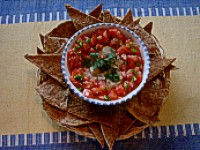
Other articles you might enjoy:
Make the most of culinary herbs and spices.
All About Savory
by Sandra Bowens

Summer or winter, savory is as great in your garden as it is in your kitchen. That's varieties, you know, not seasons. Summer savory is a much different plant from winter savory.
Summer savory (satureja hortensis) is an annual with slender branches, easily grown from seed and more delicate in flavor than winter savory (satureja montana). The winter variety is a shrubby perennial with upright woody branches suited to growing from propagation. Winter savory is popular as a border or a component in knot gardens as its maximum growth is about twelve inches. Leggy summer savory will grow to eighteen inches. Bees are attracted to both varieties' pink, white or purple flowers.
Bee stings were once relieved with crushed savory leaves. Although savory is almost exclusively a culinary herb today, it has a long history of medicinal uses that date as far back as the early Romans. From Rome, savory was introduced to England and it is said to have been one of the first plants tended by the American colonists. Both savories have been used to soothe stomach pains and curb flatulence, to promote the health of female reproductive systems and pregnancy and as an aphrodisiac.
The savories, indigenous to southern Europe and the Mediterranean, have long been used as a seasoning as well. Ancient Romans are known to combine savory with vinegar as a sauce for fish. Early England considered savory an essential ingredient for stuffing. In Germany, savory is referred to as Bohnenkraut, the bean herb, or Pfefferkraut, the pepper herb.
A member of the mint family, the savories have a somewhat peppery flavor with a minty thyme background. Summer savory is far more popular for cooking or using fresh. Winter savory, which should always be cooked, is better suited to strong meat dishes and hearty bean stews.
Summer savory will enhance fish, vegetables, cheese and eggs, pea soups, beans and many other dishes. The fresh leaves serve as a pleasant garnish. A common use in the south of France is to marinate goat cheese rounds in olive oil and savory. Tomatoes have a particular affinity for savory so you might try slipping a bit into your next tomato sauce. Summer savory combines well with other herbs, bringing out each flavor without overwhelming.
Unless you are growing it yourself, chances are high you will only be able to find savory in its dried form. It is most often marketed without the distinction of variety but you can assume it is summer savory.
Savory White Bean Puree with toasted pita chips
4 pita breads
2 Tablespoons olive oil, divided
1/2 teaspoon onion salt*
1/2 cup minced onion
1 clove garlic, minced
1 Tablespoon fresh parsley
1 teaspoon dried savory
1/4 teaspoon dried thyme
pinches of cayenne pepper
pinches of black pepper
1 can (15.5 ounces) white beans, rinsed and drained
1/4 cup (approximately) beef stock (or use chicken or vegetable stock)
2 teaspoons extra-virgin olive oil
1/2 cup diced tomato
1 small jalapeno pepper, minced
Preheat the oven to 350 degrees.
Cut the pita breads into six triangles and split each into two pieces by carefully tearing the edges apart. Arrange in a single layer on a baking sheet. Brush lightly with 1 Tablespoon of the olive oil and sprinkle with the onion salt. Bake for about 12 minutes or until light brown and crisp.
Heat the remaining 1 Tablespoon of the olive oil in a small saucepan over medium-high heat. Add the onion; cook, stirring often, for 3 minutes. Meanwhile, chop the fresh parsley with the dried savory and add to the saucepan along with the garlic, thyme and a few pinches each of cayenne and black pepper. Cook and stir a few more minutes until the onion begins to brown. Add the beans and 1/4 cup stock; cook and stir to heat through.
Using a hand-held blender (or a manual potato masher) puree the bean mixture, adding more stock if needed, to make a smooth paste. Taste for seasonings. Stir in the 2 teaspoons of extra-virgin olive oil and a bit more cayenne, if desired. Transfer to a serving bowl and garnish around the edges with a circle of the diced tomato sprinkled with the minced jalapeno. Arrange the pita chips around the bowl. Serve warm or at room temperature.
*See All About Flavored Salts to make your own onion salt.
Here's one that's full of our favorite recipes because we wrote the book! It is also full of information, helpful hints and ideas for using herbs and spices in your kitchen.
Rosalind Creasy knows all about using food plants to round out your yard. She pioneered the idea 25 years ago. This updated edition includes 300 inspiring photographs.
Our go-to guide for dealing with things that wiggle and squirm or make our plants sick.
Go home with the Herbfarm's award-winning chef as he shows you how to prepare these simple yet utterly delightful recipes.





